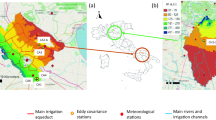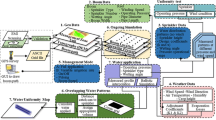Abstract
A successful water management scheme for irrigated crops requires an integrated approach, which accounts for water, soil, and crop management. SIMETAW# is a user friendly soil water balance model that assesses crop water use, irrigation requirements, and generates hypothetical irrigation schedules for a wide range of crops experiencing full or deficit irrigation. SIMETAW# calculates reference evapotranspiration (ETo), and it computes potential crop evapotranspiration (ETc), and the evapotranspiration of applied water (ETaw), which is the amount of irrigation water needed to match losses from the effective soil root zone due to ETc that are not replaced by precipitation and other sources. Using input information on crop and soil characteristics and the distribution uniformity of infiltrated irrigation applications in full or deficit conditions, the model estimates the mean depth of infiltrated water (IW) into each quarter of the field. The impact of deficit irrigation on the actual crop evapotranspiration (ETa) is computed separately for each of the four quarters of the cropped field. SIMETAW# simulation adjusts ETo estimates for projected future CO2 concentration, and hence the model can assess climate change impacts on future irrigation demand allowing the user to propose adaptation strategies that potentially lead to a more sustainable water use. This paper discusses the SIMETAW# model and evaluates its performance on estimating ETc, ETa, and ETaw for three case studies.



Similar content being viewed by others
References
Ainsworth EA, Long SP (2005) What have we learned from 15 years of free-air CO2 enrichment (FACE)? A meta-analysis of the responses of photosynthesis, canopy properties and plant production to rising CO2. New Phytol 165:351–372
Allen RG, Pereira LS, Raes D, Smith M (1998) Crop evapotranspiration. Guidelines for computing crop water requirements. Irrigation and Drainage Paper 56. FAO, Rome, Italy
Allen RG, Pereira LS, Smith M, Raes D, Wright JL (2005a) FAO-56 dual crop coefficient method for estimating evaporation from soil and application extensions. J Irrig Drain Eng 131(1):2–13
Allen RG, Walter IA, Elliott RL, Howell TA, Itenfisu D, Jensen ME, Snyder RL (2005b) The ASCE standardized reference evapotranspiration equation. American Society of Civil Engeneers, Reston
Allen RG, Pruitt WO, Wright JL, Howell TA, Ventura F, Snyder RL, Itenfisu D, Steduto P, Berengena J, Yrisarry JB, Smith M, Pereira LS, Raes D, Perrier A, Alves I, Walter I, Elliott RA (2006) Recommendation on standardized surface resistance for hourly calculation of reference ETo by the FAO56 Penman–Monteith method. Agric Water Manag 81(1–2):1–22
Bryla DR, Dickson E, Shenk R, Johnson RS, Crisosto CH, Trout TJ (2005) Influence of irrigation method and scheduling on patterns of soil and tree water status and its relation to yield and fruit quality in peach. Hortscience 40(7):2118–2124
Center for Irrigation Technology (2011) Agricultural water use in California: a 2011 update. California State University, Fresno
Doorenbos J, Kassam AH (1979) Yield response to water. Irrigation and drainage Paper 33. FAO, Rome, Italy
Doorenbos J, Pruitt WO (1977) Crop water requirements. Irrigation and Drainage Paper 24 2nd ed. FAO, Rome, Italy
Drake BG, Gonzàlez-Meler MA, Long SP (1997) More efficient plants: a consequence of rising atmospheric CO2? Annu Rev Plant Physiol 48:609–639
Guerra E, Ventura F, Spano D, Snyder RL (2014) Correcting midseason crop coefficients for climate. J Irrig Drain Eng. doi:10.1061/(ASCE)IR.1943-4774.0000839
Intergovernmental Panel on Climate Change (IPCC) (2013) In: Stocker TF, Qin D, Plattner GK, Tignor M, Allen SK, Boschung J, Nauels A, Xia Y, Bex V, Midgley PM (eds) Climate change 2013: the physical science basis. Contribution of Working Group I to the Fifth Assessment Report of the Intergovernmental Panel on Climate Change. Cambridge University Press, Cambridge
Jiménez Cisneros BE, Ok T, Arnell NW, Benito G, Cogley JG, Döll P, Jiang T, Mwakalila SS (2014) Freshwater resources. In: Field CB, Barros VR, Dokken DJ, Mach KJ, Mastrandrea MD, Bilir TE, Chatterjee M, Ebi KL, Estrada YO, Genova RC, Girma B, Kissel ES, Levy AN, MacCracken S, Mastrandrea PR, White LL (eds) Climate Change 2014: Impacts, Adaptation, and Vulnerability. Part A: Global and Sectoral Aspects. Contribution of Working Group II to the Fifth Assessment Report of the Intergovernmental Panel on Climate Change. Cambridge University Press, Cambridge, pp. 229–269
Johnson RS, Ayars J, Hsiao T (2002) Modeling young peach tree evapotranspiration. Acta Horticult 584:107–113
Loague K, Green RE (1991) Statistical and graphical methods for evaluating solute transport models: overview and application. J Contam Hydrol 7:51–73
Long SP, Ainsworth EA, Rogers A, Ort DR (2004) Rising atmospheric carbon dioxide: plants face the future. Annu Rev Plant Biol 55:591–628
Monteith JL (1965). Evaporation and environment. In: The state and movement of water in living organisms, XIXth Symposium of the Society for Experimental Biology. Swansea, Cambridge University Press, p 205–234
Moratiel R, Nicolosi P, Spano D, Snyder RL (2013) Correcting soil water balance calculations for dew, fog, and light rainfall. Irrig Sci 31(3):423–429
Orang M, Snyder RL, Geng S, Hart Q, Sarreshteh S, Eching S (2013) California simulation of evapotranspiration of applied water and agricultural energy use in California. J Integr Agr 12(8):1371–1388
Snyder RL, O’Connel NV (2007) Crop coefficients for microsprinkler-irrigated, clean-cultivated, mature citrus in an arid climate. J Irrig Drain E-Asce 133(1):43–52
Snyder RL, Pruitt WO (1992) Evapotranspiration data management in California. Proceedings of the Water Forum’92—Irrigation and Drainage Session, ASCE, New York, pp. 128–133
Snyder RL, Geng S, Orang MN, Matyac JS, Sarreshteh S (2004) A simulation model for ET of applied water. Acta Horticult 664:623–629
Snyder RL, Moratiel R, Song Z, Swelam A, Jomaa I, Shapland T (2011) Evapotranspiration response to climate change. Acta Hort. doi:10.17660/ActaHortic.2011.922.11
Snyder RL, Geng S, Orang MN, Sarreshteh S (2012a) Calculation and simulation of evapotranspiration of applied water. J Integr Agr 11(3):489–501
Snyder RL, Shapland TM, Rejmanek H (2012b) Evapotranspiration and crop coefficient for winter wheat. University of California, Davis, unpublished report to the California Department of Water Resources on Standard Agreement No. 4600008548, Task # 10
Ventura F, Snyder RL, Bali KM (2006) Estimating evaporation from bare soil using soil moisture data. J Irrig Drain E-Asce 132(2):153–158
Xevi E, Gilley J, Feyen J (1996) Comparative study of two crop yield simulation models. Agric Water Manag 30:155–173
Acknowledgments
This research was funded by the Ph.D. program in Agrometeorology and Ecophysiology of Agricultural and Forest Systems (Ph.D. school in Science and Biotechnology of Agricultural Systems, Forestry and Food production) of the University of Sassari in collaboration with the University of California–Davis; the European Community’s Seventh Framework Program (FP7/2007-2013) under grant agreement 244255 (WASSERMed project), and the Italian MIUR and MATTM (Gemina project) under grant agreement 232/2011. Software development was also supported by the California Department of Water Resources.
Author information
Authors and Affiliations
Corresponding author
Ethics declarations
Conflict of Interest
The authors declare no conflict of interest.
Rights and permissions
About this article
Cite this article
Mancosu, N., Spano, D., Orang, M. et al. SIMETAW# - a Model for Agricultural Water Demand Planning. Water Resour Manage 30, 541–557 (2016). https://doi.org/10.1007/s11269-015-1176-7
Received:
Accepted:
Published:
Issue Date:
DOI: https://doi.org/10.1007/s11269-015-1176-7




